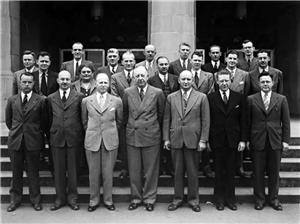On October 2, 1946, the University of Washington formally opens a medical school as part of a School of Health Sciences. The school will soon expand to include the School of Dentistry, the School of Nursing (founded in 1922), and the School of Pharmacy.
Intentions and Attempts
The idea of a medical school originated with the founding of the territorial university in 1861. The Articles of Incorporation mandated a Department of Medicine despite the dearth of citizens qualified even to enter high school.
In 1884 a three-man committee appointed by the Board of Regents (Gideon Weed, Rufus Willard, and Thomas Minor) worked out an organizational plan for a medical school along with a faculty drawn from town physicians. However, the state legislature declined to fund the plan.
In 1916, University of Washington President Henry Suzzallo (1875-1933) appointed faculty in anatomy, biochemistry, bacteriology, and pathology in order to establish a pre-med program and in the hope that it might lead to a medical school. But the university board of regents, practicing physicians, and the state legislature all failed to support the idea of a medical school.
Suzzallo inaugurated a nursing program in 1918 (the year of the devastating flu pandemic) by establishing a summer course in public health nursing. Seattle nurse Elizabeth Sterling Soule founded the University of Washington Department of Nursing in 1922.
During the early twentieth century, university medical schools in other parts of the country advanced research and the quality of care. This was one factor, according to historian Clement A. Finch, that led regents, doctors, and legislators to finally support a UW medical school. In addition, after World War II returning GIs were looking for education and new careers, there was a shortage of physicians, practicing physicians wanted continuing education, and medical school applicants had a need for their own state school.
A School of Health Sciences
The Washington State Medical Association had long opposed the founding of a UW medical school, not wishing to create a competitive surplus of physicians. But in 1944, perhaps sensing the inevitable, the association appointed David Methany, Seattle surgeon and Chief of Staff at Harborview Hospital, to chair a committee to study the feasibility of establishing a medical school for the training of doctors and dentists.
The university agreed that a school should be started as soon as possible. Then-Senator (later Governor) Albert Rosellini (1910-2011), a major supporter of the medical school, introduced a bill in the state legislature. Rosellini moved the bill through both houses of the legislature and onto the governor's desk in a record two months. The bill established the School of Health Sciences and provided $3.75 million for buildings and $450,000 for salaries. Governor Monrad Wallgren (1891-1961) signed it on March 15, 1945. The Medical Association lobbied to limit graduates of the UW medical school to 50, but without success.
The Regents named Dr. Edward L. Turner as dean of the medical school and Dr. Ernest M. Jones as dean of the school of dentistry. Dr. Turner struggled with inadequate financing, but built a faculty consisting of eight UW faculty members imported from other parts of the university and eight new hires from institutions such as Yale and Northwestern universities. Construction of a Health Sciences Building began in 1947, south of NE Pacific Street, site of a U.S. Navy training camp during World War I and later a golf course.
In the fall of 1947, the first class of 50 medical students was admitted. Affiliation agreements were made with community hospitals to prepare for clinical teaching. The most important of these was King County's hospital, Harborview. The first class graduated in the spring of 1950.

